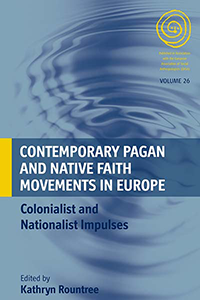Letter from the Book Series Editor
 The EASA book series is published by Berghahn Books, and has produced about two dozen titles since 2003. Prior
to that, Routledge published another two dozen or so volumes starting in 1992. The full list of titles is on the
EASA website, www.easaonline.org/bookseri.shtml.
The series includes both edited collections and monographs. If you are thinking about producing a book, or want
to know more about the series, please take a look at the website or email me eeva.berglund(at)helsinki.fi
The EASA book series is published by Berghahn Books, and has produced about two dozen titles since 2003. Prior
to that, Routledge published another two dozen or so volumes starting in 1992. The full list of titles is on the
EASA website, www.easaonline.org/bookseri.shtml.
The series includes both edited collections and monographs. If you are thinking about producing a book, or want
to know more about the series, please take a look at the website or email me eeva.berglund(at)helsinki.fi
Berghahn Books is a very well regarded publisher in anthropology and many other fields of interest to EASA members. Although Berghahn is the publisher, the series is run by an editor appointed by the EASA Executive. The editor’s job includes liaising with prospective authors and editors, helping proposers improve a proposal or manuscript where possible, and arranging for their evaluation by expert reviewers. The editor also makes decisions about which proposals and manuscripts to accept for publication and submits these suggestions to Berghahn for approval.
Whether you are just beginning to think about publishing your work, or have already started to compile a book proposal or manuscript, I would be happy to hear from you. I often exchange ideas and suggestions with prospective EASA authors over email, or talk to them at events. I can make suggestions for strengthening a proposal before moving on to the next stage, that is, sending the proposal to specialist reviewers for expert comment.
It’s unusual for people to send me a full manuscript in the first instance, it is more typical to start with a proposal. There is no fixed template for this, but the material you send in should show what the book will be about, persuade me that the topic is interesting and the argument coherent and convincing. Often the proposal reads like a short draft of the work’s Introduction, making those points in a concise way. In addition, the proposal should include an abstract (not much more than 300 words) of each chapter (for monographs) or each contribution (for edited volumes). At some point, a form from Berghahn called the New Book Outline will also need to be filled in. Doing this is helpful to a proposer, as the form asks specific questions about the book, such as what other similar books are in production or recently published, and who is the intended readership.
The process of producing a book is a collective effort, and it has many stages. Only a few proposals are good enough to be offered a contract by Berghahn. Proposers may be invited to revise proposals in light of comments from specialists and from me, or they can be encouraged to get to work on a manuscript based on the comments received. Revisions to proposals or to completed manuscripts can be substantial or they can be minor, but clear requirements will be agreed between a proposer and me as the series editor.
In the last instance the decision to publish lies with Berghahn, but so far they have agreed with the series editor’s suggestions. Getting a book published is not always straightforward, but the basics are fairly simple: a person proposes a project, we work to make it as strong as we can, we see what specialist readers have to say. I look forward to hearing from you.
Eeva Berglund
Book Series Editor, EASA






